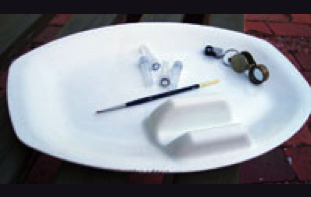Thrips of the British Isles
Collecting and preparing thrips
Usually, thrips species cannot be identified without mounting specimens onto microscope slides. Slide preparation techniques are best considered under two headings:
But the quality and value of slide mounts is largely dependent on the care with which specimens are collected and preserved.
Collecting
Thrips may be collected into a fluid known as AGA, a mixture of 10 parts of 60% ethanol with 1 part of glycerine and 1 part of acetic acid. This mixture helps to distend the body of most thrips and keeps the body parts supple. Alternatively, the thrips may be collected into 80-95% ethanol, and provided that they are subsequently stored in a freezer may still yield reasonable quality microscope slides. Specimens preserved this way are particularly useful for DNA studies.

equipment

beating technique
Thrips may be beaten from flowers, leaves and dead twigs. A small and heavy garden trowel is an example of a suitable beating implement, as it is small enough to direct effort toward selected plants. The most convenient beating tray for thrips is a bespoke or improvised white plastic one (the illustration shows a pre-moulded party tray commonly sold in Australia). The feet of thrips adhere to the plastic surface, and the thrips can be picked off with a small brush or grass stem into the collecting fluid in tubes. Suitable brushes, such as a synthetic fine art brush size 2/0, can be bought from any artists' supplies shop.
The best tubes for field use are plastic Eppendorf Tubes, as used in molecular biology laboratories for centrifuging, because these have screw tops that include a sealing ring, and neither leak nor break. Ensure that each tube contains a sample identification label, either printed or written in pencil. The more precise the information recorded at this stage the greater the value of the resulting slide mounted specimen. Useful information includes the date, location, plant species, part of the plant from which the specimens were taken, and whether or not larvae were present (potentially indicating a true reproductive host; adults are often found, wind-blown, on non-hosts).
If possible, specimens should be transferred to 60% ethanol for longer-term storage. Regardless, specimens stored in alcohol should be kept in the dark, preferably at temperatures well below 0°C, to prevent loss of colour.
